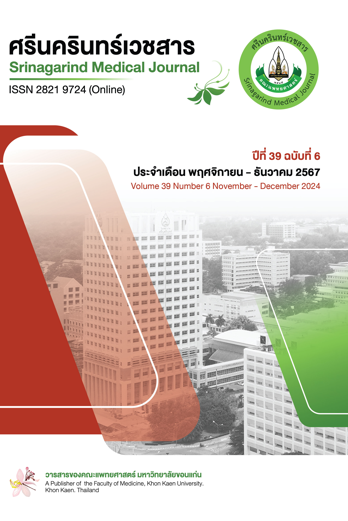การประเมินปริมาณรังสีที่ผิวหนัง เลนส์ตา และต่อมไทรอยด์จากการตรวจช่องท้องด้วยเครื่องเอกซเรย์คอมพิวเตอร์ (การวิจัยนำร่อง)
คำสำคัญ:
เอกซเรย์คอมพิวเตอร์ช่องท้อง, ค่าดัชนีปริมาณรังสีเชิงปริมาตรของซีที, ค่าผลคูณปริมาณรังสีกับความยาวของสแกน, ค่าปริมาณรังสียังผล, ค่าปริมาณรังสีวินิจฉัยอ้างอิงบทคัดย่อ
หลักการและวัตถุประสงค์: การตรวจช่องท้องด้วยเครื่องเอกซเรย์คอมพิวเตอร์มีความจำเป็นต่อการวินิจฉัยโรคและมีแนวโน้มเพิ่มขึ้น อย่างไรก็ตามรังสีเอกซ์เป็นอันตรายต่อเซลล์ในร่างกาย จำเป็นต้องเฝ้าระวังค่าปริมาณรังสีที่ผู้ป่วยได้รับจากการตรวจ การศึกษานี้จึงมีวัตถุประสงค์เพื่อประเมินปริมาณรังสีจากการตรวจเอกซเรย์คอมพิวเตอร์ช่องท้องส่วนบน ล่าง และช่องท้องทั้งหมด และเปรียบเทียบกับปริมาณรังสีอ้างอิงของประเทศรวมถึงประเมินปริมาณรังสีที่ผิวบริเวณช่องท้อง เลนส์ตา และต่อมไทรอยด์
วิธีการศึกษา: การศึกษานี้เป็นการศึกษาเชิงพรรณนา ภาคตัดขวาง แบ่งออกเป็น 2 กลุ่ม ได้แก่ กลุ่มที่ 1 ผู้ป่วยอาสาสมัครที่ตรวจเอกซเรย์คอมพิวเตอร์ช่องท้องส่วนบน และช่องท้องทั้งหมด ในช่วงเดือนกรกฎาคม พ.ศ. 2565 – มีนาคม พ.ศ. 2566 และผ่านเกณฑ์คัดเข้า 30 ราย และกลุ่มที่ 2 ศึกษาในหุ่นจำลองเนื้อเยื่อ ประเมินปริมาณรังสีโดยติดอุปกรณ์วัดปริมาณรังสีโอเอสแอลดีชนิดนาโนดอทเพื่อวัดปริมาณรังสีที่ผิวบริเวณตา ไทรอยด์ และช่องท้อง ของหุ่นจำลอง จากนั้นเก็บข้อมูลปริมาณรังสีได้แก่ ค่าดัชนีปริมาณรังสีเชิงปริมาตรของซีที (CTDIvol) ค่าผลคูณปริมาณรังสีกับความยาวของการสแกน (DLP) และคำนวณค่าปริมาณรังสียังผล
ผลการศึกษา: กลุ่มที่ 1 ค่า CTDIvol (8.46มิลลิเกรย์) ค่า DLP (1,171 มิลลิเกรย์.เซนติเมตร) และค่าปริมาณรังสียังผล (17.5 มิลลิซีเวริต์) มีค่ามากที่สุดจากการตรวจด้วยเอกซเรย์คอมพิวเตอร์ส่วนช่องท้องทั้งหมด ในกลุ่มผู้ป่วยอาสาสมัคร ค่า CTDIvol และ DLP จากการตรวจเอกซเรย์คอมพิวเตอร์ช่องท้องส่วนบน และช่องท้องทั้งหมด มีค่าไม่เกินค่าปริมาณรังสีอ้างอิงของประเทศไทย ปริมาณรังสีเฉลี่ยที่ผิวบริเวณเลนส์ตา (0.21±0.06 มิลลิเกรย์) ต่อมไทรอยด์ (0.69±0.28 มิลลิเกรย์) และช่องท้อง (25.34±7.85 มิลลิเกรย์) จากการตรวจเอกซเรย์ช่องท้องทั้งหมดมีค่ามากที่สุด กลุ่มที่ 2 พบปริมาณรังสีค่าเฉลี่ยที่ผิวบริเวณช่องท้องได้รับค่าสูงที่สุดจากการตรวจเอกซเรย์คอมพิวเตอร์ช่องท้องทั้งหมด (39.19±2.38มิลลิเกรย์) โดยปริมาณรังสีที่ผิวบริเวณช่องท้องด้านขวาจะสูงกว่าด้านซ้ายเล็กน้อย ปริมาณรังสีที่ผิวบริเวณต่อมไทรอยด์จากการตรวจเอกซเรย์คอมพิวเตอร์ช่องท้องทั้งหมด ทั้งข้างซ้ายและข้างขวามีค่าสูงที่สุด (0.90±0.14, 0.92±0.04 มิลลิเกรย์) ปริมาณรังสีที่ผิวบริเวณเลนส์ตาพบว่าปริมาณรังสีที่ตาซ้ายจากการตรวจช่องท้องทั้งหมดมีค่าสูงที่สุด (0.43±0.04 มิลลิเกรย์)
สรุป: ค่า CTDIvol และ DLP ในการตรวจช่องท้องด้วยเครื่องเอกซเรย์คอมพิวเตอร์มีค่าต่ำกว่าปริมาณรังสีอ้างอิงของประเทศไทยและสหรัฐอเมริกา ข้อมูลที่ได้จากการศึกษานี้สามารถนำมาใช้เป็นแนวทางในการปรับเปลี่ยนพารามิเตอร์เพื่อลดปริมาณรังสีให้กับผู้ป่วยโดยที่คุณภาพของภาพถ่ายรังสียังคงมีประสิทธิภาพในการวินิจฉัยโรคได้แม่นยำถูกต้อง
References
The Organisation for Economic Cooperation and Development. Computed tomography (CT) exams (indicator). [cited August 1, 2023]. https://data.oecd.org/healthcare/computed-tomography-ct-exams.html
Poosiri S, Krisanachinda A, Khamwan K. Evaluation of patient radiation dose and risk of cancer from CT examinations. Radiol Phy Technol 2024;17:176-85. doi:10.1007/s12194-023-00763-w.
Berrington de GA, Darby S. Risk of cancer from diagnostic X-rays: estimates for the UK and 14 other countries. Lancet 2004;363(9406):345-51. doi:10.1016/S0140-6736(04)15433-0
Vano E, Miller DL, Martin CJ, Rehani MM, Kang K, Rosenstein M, et al. ICRP Publication 135: diagnostic reference levels in medical imaging. Ann ICRP 2017;46(1):1-44. doi:10.1177/0146645317717209
Kanal KM, Butler PF, Sengupta D, Bhargavan-Chatfield M, Coombs LP, Morin RL. U.S. diagnostic reference levels and achievable doses for 10 adult CT examinations. Radiology 2017;284(1):120-33. doi:10.1148/radiol.2017161911
Department of Medical Sciences Ministry of Public Health. National diagnostic reference levels in Thailand 2021. Bangkok: Beyond Publishing Co., Ltd., 2021.
Pema D, Kritsaneepaiboon S. Radiation dose from computed tomography scanning in patients at Songklanagarind Hospital: diagnostic reference levels. J Health Sci Med Res 2020;38(2):135-43. doi: 10.31584/jhsmr.2020732
Ngaodingam W. Radiation dose in patient underwent computed tomography scan at Sichon Hospital. J Nakornping Hosp 2021;12(2):97-107.
Chokchai B. Assessment of radiation dose from abdominal computed tomography at Maharat Nakhon Ratchasima Hospital. Thai J Rad Tech 2023;48(1):110-8.
Sodkokruad P, Asvaphatiboon S, Thanabodeebonsiri J, Tangboonduangit P. Comparision of computed tomography dose index measuring by two detector types of computed tomography simulator. Thai J Rad Tech 2018;43(1):64-8.
Virginia TS, John EA, Raju S, Maria AS, Anchali K, Madan R, et al. Dose reduction in CT while maintaining diagnostic confidence: diagnostic reference levels at routine head, chest and abdominal CT-IAEA-coordinated research project. Radiology 2006;240(3):828-34. doi:10.1148/radiol.2403050993
Kuepitak K, Thananon J, Awikunprasert P, Sangsawang S, Rueangsitrakoon J, Pungkun V, et al. The study of radiation dose and radiation scattering from computed tomography in a model. J Med Health Sci 2019;26(1):19-28.
Nupetch S, Awikunprasert P, Pungkun V. Radiation dose response of Inlight® optically stimulated luminescence (OSL) dosimeter. Thai J Rad Tech 2018;43(1):36-43.
Department of Medical Sciences, Ministry of Public Health. National diagnostic reference levels in Thailand 2023. Bangkok: Beyond Publishing Co., Ltd., 2023.
Pimsorn P. Factor affecting size–specific dose estimates in addition to scanning parameters for chest–abdomen–pelvis computed tomography using automatic tube current modulation at Chiangrai Prachanukroh Hospital. Thai J Rad Tech 2022;47(1):43-54.
llisy-Roberts P, Williams J. Chapter 1-Radiation physics. W.B. Saunders; 2008: 1–21. [cited August 1, 2023]. Available from: https://www.sciencedirect.com/science/article/pii/B9780702028441500053. doi:10.1016/B978-0-7020-2844-1.50005-3
Mancosu P, Ripamonti D, Veronese I, Cantone MC, Giussani A, Tosi G. Angular dependence of the TL reading of thin alpha Al2O3: C dosemeters exposed to different beta spectra.. Radiat Prot Dosimetry 2005;113(4):359–65. doi:10.1093/rpd/nch476.
Okazaki T, Hayashi H, Takegami K, Okino H, Kimoto N, Maehata I, et al. Fundamental study of nanoDot OSL dosimeters for entrance skin dose measurement in diagnostic x-ray examinations. J Radiat Prot Res 2016;41(3):229–36. doi:10.14407/jrpr.2016.41.3.229
Jursinic PA. Optically stimulated luminescent dosimeters stable response to dose after repeated bleaching. Med Phys 2020;47(7):3191-203. doi:10.1002/mp.14182
Zhuang AH, Olch AJ. A practical method for the reuse of nanoDot OSLDs and predicting sensitivities up to at least 7000 cGy. Med Phys 2020;47(4):1481-8. doi:10.1002/mp.14059
Trinavarat P, Kritsaneepaiboon S, Rongviriyapanich C, Visrutaratna P, Srinakarin J. Radiation dose from CT scanning: can it be reduced? Asian Biomedicine 2011;5(1):13-21. doi:10.5372/1905-7415.0501.002
Nuntue C, Krisanachinda A, Khamwan K. Optimization of a low-dose 320-slice multidetector computed tomography chest protocol using a phantom. Asian Biomedicine 2016;10(3):269-76. doi:10.5372/1905-7415.1003.490
Downloads
เผยแพร่แล้ว
How to Cite
ฉบับ
บท
License
Copyright (c) 2024 ศรีนครินทร์เวชสาร

This work is licensed under a Creative Commons Attribution-NonCommercial-NoDerivatives 4.0 International License.



